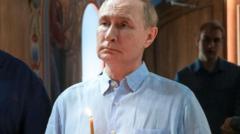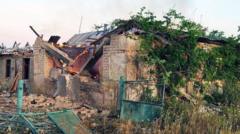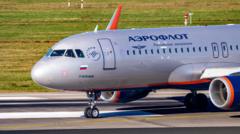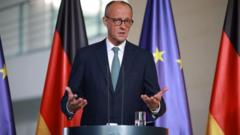As frontline soldiers return home, they battle 'droneophobia', a condition rooted in the incessant presence of drone warfare.
**Drones of War: The Psychological Toll on Soldiers and Civilians in Ukraine**

**Drones of War: The Psychological Toll on Soldiers and Civilians in Ukraine**
The evolving landscape of warfare in Ukraine has unleashed new traumas associated with drone sounds, affecting both soldiers and civilians.
In a modest apartment nestled in Kyiv, Pavlo, a 30-year-old drone pilot recently returned from Ukraine's frontlines, attempted to fly his drone indoors. The device, a four-rotor FPV (first-person view) drone, is indicative of a modern warfare tactic that has fundamentally shifted the battleground and mental health challenges for soldiers. “Sorry, not today,” he chuckled, disappointingly noting the malfunction of his equipment.
Pavlo recounts the chilling essence of drone warfare, where the whir of FPVs—small, nimble drones armed with explosives—have become synonymous with death and destruction on the battlefield. “You are being hunted,” he stated, remarking on the paranoia induced by these machines that relentlessly pursue soldiers and units. As the sound of drones dissipated momentarily as he returned home, whispers echoed in his memory—ordinary sounds reminiscent of drones now incited panic rather than comfort. “I don’t like going into nature anymore and hearing this sound; it brings back haunting memories,” he admitted.
The psychological impact of drone warfare is starkly evident: Dr. Serhii Andriichenko, chief psychiatrist at a Kyiv military hospital, remarked that many returning service members suffer from acute stress disorders categorized as "droneophobia." This condition manifests through heightened awareness of everyday sounds—scooters, lawnmowers, and air conditioners—triggering memories of past fears. Savur, another soldier who has lost an arm to drone action, echoes Pavlo’s sentiments, expressing how drone sounds linger like a ghost that refuses to fade away.
Conversely, the characteristics of drone warfare have transformed traditional combat experiences. While earlier phases of the conflict left soldiers wary of forests, the omnipresence of drones has flipped this notion. Places deemed safe, such as wooded areas, are now avoided as they remind them of vulnerability against aerial threats.
Moreover, the drone warfare extends far beyond the frontlines, shaking the very cores of civilian life. In Kherson, civilians endure daily torment from drone strikes. Dmytro Olifirenko, a 23-year-old border guard, speaks of the trauma inflicted as he was wounded by a drone targeting a civilian bus stop. “There is no such thing as a safe place anymore,” he shares, highlighting the dramatic shift in civilian existence amidst the constant underlying threat.
The inherent dangers of drones are a stark contrast to traditional warfare experiences, creating new psychoses within soldiers and their families. As Pavlo and countless others find their lives marked by sounds they can’t escape—both as hunters and hunted—Ukraine’s brutal evolution into a conflict driven by drone tech poses challenges that stretch far beyond the battlefield. "When you see something, your brain can check it instantly, but an unknown sound means your life may very well depend on your response," Pavlo articulated, reflecting the unspeakable realities that haunt both soldiers and civilians in this unprecedented technological war.
Pavlo recounts the chilling essence of drone warfare, where the whir of FPVs—small, nimble drones armed with explosives—have become synonymous with death and destruction on the battlefield. “You are being hunted,” he stated, remarking on the paranoia induced by these machines that relentlessly pursue soldiers and units. As the sound of drones dissipated momentarily as he returned home, whispers echoed in his memory—ordinary sounds reminiscent of drones now incited panic rather than comfort. “I don’t like going into nature anymore and hearing this sound; it brings back haunting memories,” he admitted.
The psychological impact of drone warfare is starkly evident: Dr. Serhii Andriichenko, chief psychiatrist at a Kyiv military hospital, remarked that many returning service members suffer from acute stress disorders categorized as "droneophobia." This condition manifests through heightened awareness of everyday sounds—scooters, lawnmowers, and air conditioners—triggering memories of past fears. Savur, another soldier who has lost an arm to drone action, echoes Pavlo’s sentiments, expressing how drone sounds linger like a ghost that refuses to fade away.
Conversely, the characteristics of drone warfare have transformed traditional combat experiences. While earlier phases of the conflict left soldiers wary of forests, the omnipresence of drones has flipped this notion. Places deemed safe, such as wooded areas, are now avoided as they remind them of vulnerability against aerial threats.
Moreover, the drone warfare extends far beyond the frontlines, shaking the very cores of civilian life. In Kherson, civilians endure daily torment from drone strikes. Dmytro Olifirenko, a 23-year-old border guard, speaks of the trauma inflicted as he was wounded by a drone targeting a civilian bus stop. “There is no such thing as a safe place anymore,” he shares, highlighting the dramatic shift in civilian existence amidst the constant underlying threat.
The inherent dangers of drones are a stark contrast to traditional warfare experiences, creating new psychoses within soldiers and their families. As Pavlo and countless others find their lives marked by sounds they can’t escape—both as hunters and hunted—Ukraine’s brutal evolution into a conflict driven by drone tech poses challenges that stretch far beyond the battlefield. "When you see something, your brain can check it instantly, but an unknown sound means your life may very well depend on your response," Pavlo articulated, reflecting the unspeakable realities that haunt both soldiers and civilians in this unprecedented technological war.





















